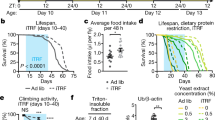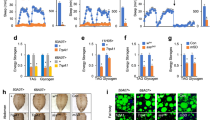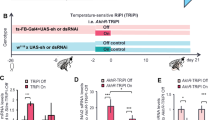Abstract
Background:
Recent studies have led to an expansion of potential factors capable of stimulating obesity. Increasing evidence indicates that environmental factors, including disturbance of circadian rhythms, also contribute to its etiology.
Objectives:
To determine the effects of altered circadian rhythms on adipogenesis and to better understand how circadian and adipogenic regulatory pathways are linked, zebrafish larvae were exposed to various light/dark cycles or hypercaloric feeding (HCF).
Methods:
Clock and adipogenic gene expression was quantitative real time PCR. Adipogenesis was characterized using coherent anti-Stokes Raman scattering microscopy (CARS) and whole-mount lipid composition was analyzed by gas chromatography. The clock protein Rev-erbα and the adipogenesis-regulating protein Pparγ were localized by immunohistochemistry.
Results:
Zebrafish larvae exposed to continuous light (LL) had a sevenfold higher prevalence of adipocytes compared with control fish under a 14 h light and 10 h dark cycle. It was also significantly higher compared with that in HCF larvae with control light/dark cycle, which showed a 5.5-fold increase compared with control animals. Although total fatty acid content was unaffected, adipocyte lipid composition was altered in LL zebrafish. In contrast, shifting the onset and duration of the light periods did not affect adipogenesis or total fatty acid content. Gene expression analysis revealed effects of LL and HCF on circadian cyclicity, with increased expression of the clock gene period2 and altered circadian rev-erbα expression in LL larvae. Immunostaining revealed for the first time that Rev-erbα and Pparγ colocalize in adipocytes, which together with the gene expression analysis suggests interplay between Rev-erbα and Ppar isoforms.
Conclusions:
The amount of light, but not shifted light/dark cycles, affected adipogenesis and lipid composition, possibly due to increased period2 expression, which, in turn, enhances Rev-erbα-regulated gene expression. As the pparβδ promoter includes three Rev-erbα binding sites, we hypothesize that pparβδ may be a direct target that ultimately activates Pparγ.
This is a preview of subscription content, access via your institution
Access options
Subscribe to this journal
Receive 12 print issues and online access
$259.00 per year
only $21.58 per issue
Buy this article
- Purchase on Springer Link
- Instant access to full article PDF
Prices may be subject to local taxes which are calculated during checkout






Similar content being viewed by others
References
Legler J, Hamers T, van Eck van der Sluijs-van de Bor M, Schoeters G, van d V L, Eggesbo M et al. The OBELIX project: early life exposure to endocrine disruptors and obesity. Am J Clin Nutr 2011; 94 (Suppl): 1933S–1938S.
Arnold J, Janoska M, Kajon AE, Metzgar D, Hudson NR, Torres S et al. Genomic characterization of human adenovirus 36, a putative obesity agent. Virus Res 2010; 149: 152–161.
Atkinson RL, Dhurandhar NV, Allison DB, Bowen RL, Israel BA, Albu JB et al. Human adenovirus-36 is associated with increased body weight and paradoxical reduction of serum lipids. Int J Obes (Lond) 2005; 29: 281–286.
Klimentidis YC, Beasley TM, Lin HY, Murati G, Glass GE, Guyton M et al. Canaries in the coal mine: a cross-species analysis of the plurality of obesity epidemics. Proc Biol Sci 2011; 278: 1626–1632.
Gooley JJ, Chua EC . Diurnal regulation of lipid metabolism and applications of circadian lipidomics. J Genet Genomics 2014; 41: 231–250.
Dochi M, Suwazono Y, Sakata K, Okubo Y, Oishi M, Tanaka K et al. Shift work is a risk factor for increased total cholesterol level: a 14-year prospective cohort study in 6886 male workers. Occup Environ Med 2009; 66: 592–597.
Karlsson B, Knutsson A, Lindahl B . Is there an association between shift work and having a metabolic syndrome? Results from a population based study of 27,485 people. Occup Environ Med 2001; 58: 747–752.
Ye R, Selby CP, Chiou YY, Ozkan-Dagliyan I, Gaddameedhi S, Sancar A . Dual modes of CLOCK:BMAL1 inhibition mediated by Cryptochrome and Period proteins in the mammalian circadian clock. Genes Dev 2014; 28: 1989–1998.
Wang N, Yang G, Jia Z, Zhang H, Aoyagi T, Soodvilai S et al. Vascular PPARgamma controls circadian variation in blood pressure and heart rate through Bmal1. Cell Metab 2008; 8: 482–491.
Laitinen S, Fontaine C, Fruchart JC, Staels B . The role of the orphan nuclear receptor Rev-Erb alpha in adipocyte differentiation and function. Biochimie 2005; 87: 21–25.
Coste H, Rodriguez JC . Orphan nuclear hormone receptor Rev-erbalpha regulates the human apolipoprotein CIII promoter. J Biol Chem 2002; 277: 27120–27129.
Pando MP, Morse D, Cermakian N, Sassone-Corsi P . Phenotypic rescue of a peripheral clock genetic defect via SCN hierarchical dominance. Cell 2002; 110: 107–117.
Vatine G, Vallone D, Gothilf Y, Foulkes NS . It's time to swim! Zebrafish and the circadian clock. FEBS Lett 2011; 585: 1485–1494.
Delaunay F, Thisse C, Marchand O, Laudet V, Thisse B . An inherited functional circadian clock in zebrafish embryos. Science 2000; 289: 297–300.
Emery P, Reppert SM . A rhythmic Ror. Neuron 2004; 43: 443–446.
Cahill GM . Circadian regulation of melatonin production in cultured zebrafish pineal and retina. Brain Res 1996; 708: 177–181.
Schlegel A, Stainier DY . Lessons from ‘lower’ organisms: what worms, flies, and zebrafish can teach us about human energy metabolism. PLoS Genet 2007; 3: e199.
Davidson AJ, Sellix MT, Daniel J, Yamazaki S, Menaker M, Block GD . Chronic jet-lag increases mortality in aged mice. Curr Biol 2006; 16: R914–R916.
Amaral IP, Johnston IA . Circadian expression of clock and putative clock-controlled genes in skeletal muscle of the zebrafish. Am J Physiol Regul Integr Comp Physiol 2012; 302: R193–R206.
Billecke N, Rago G, Bosma M, Eijkel G, Gemmink A, Leproux P et al. Chemical imaging of lipid droplets in muscle tissues using hyperspectral coherent Raman microscopy. Histochem Cell Biol 2014; 141: 263–273.
Liu YX, Lee YJ, Cicerone MT . Broadband CARS spectral phase retrieval using a time-domain Kramers-Kronig transform. Opt Lett 2009; 34: 1363–1365.
Parekh SH, Lee YJ, Aamer KA, Cicerone MT . Label-free cellular imaging by broadband coherent anti-Stokes Raman scattering microscopy. Biophys J 2010; 99: 2695–2704.
Rinia HA, Burger KN, Bonn M, Muller M . Quantitative label-free imaging of lipid composition and packing of individual cellular lipid droplets using multiplex CARS microscopy. Biophys J 2008; 95: 4908–4914.
Kakizawa T, Nishio S, Triqueneaux G, Bertrand S, Rambaud J, Laudet V . Two differentially active alternative promoters control the expression of the zebrafish orphan nuclear receptor gene Rev-erbalpha. J Mol Endocrinol 2007; 38: 555–568.
Greenberg AS, Coleman RA, Kraemer FB, McManaman JL, Obin MS, Puri V et al. The role of lipid droplets in metabolic disease in rodents and humans. J Clin Invest 2011; 121: 2102–2110.
Wang H, Storlien LH, Huang XF . Effects of dietary fat types on body fatness, leptin, and ARC leptin receptor, NPY, and AgRP mRNA expression. Am J Physiol Endocrinol Metab 2002; 282: E1352–E1359.
Lee G, Elwood F, McNally J, Weiszmann J, Lindstrom M, Amaral K et al. T0070907, a selective ligand for peroxisome proliferator-activated receptor gamma, functions as an antagonist of biochemical and cellular activities. J Biol Chem 2002; 277: 19649–19657.
Schmutz I, Ripperger JA, Baeriswyl-Aebischer S, Albrecht U . The mammalian clock component PERIOD2 coordinates circadian output by interaction with nuclear receptors. Genes Dev 2010; 24: 345–357.
Acknowledgements
We thank Jurjen Broeke, Peter Cenijn, Philip Nijssen, Gerda Hopman-Ubbels and the Animal Caretakers of the VU University Amsterdam for their support in carrying out the experiments. We acknowledge the financial support by the European Union (FP7-PEOPLE-IEF, 303197 Obesity and Light and the Marie Curie Foundation No. CIG322284) and the Netherlands Organization for Scientific Research (VIDI/864.09.005).
Author information
Authors and Affiliations
Corresponding authors
Ethics declarations
Competing interests
The authors declare no conflict of interest.
Additional information
Supplementary Information accompanies this paper on International Journal of Obesity website
Supplementary information
Rights and permissions
About this article
Cite this article
Kopp, R., Billecke, N., Legradi, J. et al. Bringing obesity to light: Rev-erbα, a central player in light-induced adipogenesis in the zebrafish?. Int J Obes 40, 824–832 (2016). https://doi.org/10.1038/ijo.2015.240
Received:
Revised:
Accepted:
Published:
Issue Date:
DOI: https://doi.org/10.1038/ijo.2015.240
This article is cited by
-
Current basis and future directions of zebrafish nutrigenomics
Genes & Nutrition (2019)
-
Alterations in locomotor activity of feeding zebrafish larvae as a consequence of exposure to different environmental factors
Environmental Science and Pollution Research (2018)



